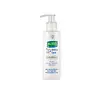What's inside
What's inside
 Key Ingredients
Key Ingredients

 Benefits
Benefits

 Concerns
Concerns

 Ingredients Side-by-side
Ingredients Side-by-side

Water
Skin ConditioningPropylene Glycol
HumectantCetyl Alcohol
EmollientGlycerin
HumectantSodium Methyl Cocoyl Taurate
CleansingCetearyl Alcohol
EmollientAloe Barbadensis Leaf Water
MaskingMethyl Gluceth-20
HumectantHexylglycerin
Humectant1,2-Hexanediol
Skin ConditioningCaprylyl Glycol
EmollientDisodium EDTA
Salicylic Acid
MaskingHydrolyzed Royal Jelly Protein
Skin ConditioningPhenoxyethanol
Preservative3-O-Ethyl Ascorbic Acid
Skin ConditioningWater
Skin ConditioningGlycerin
HumectantPalmitic Acid
EmollientButylene Glycol
HumectantPEG-2 Stearate
EmulsifyingMyristic Acid
CleansingPotassium Hydroxide
BufferingLauric Acid
CleansingOlea Europaea Husk Oil
Skin ConditioningLauramide DEA
Potassium Lauroyl Glutamate
CleansingAlcohol
AntimicrobialPotassium Chloride
Sodium Hydroxide
BufferingParfum
MaskingLauryl Hydroxysultaine
CleansingTocopheryl Acetate
AntioxidantO-Cymen-5-Ol
AntimicrobialDipotassium Glycyrrhizate
HumectantTocopherol
AntioxidantSodium Chloride
MaskingLactic Acid
BufferingMagnesium Ascorbyl Phosphate
AntioxidantSaxifraga Sarmentosa Extract
Skin ConditioningCI 77288
Cosmetic ColorantCI 77492
Cosmetic ColorantWater, Glycerin, Palmitic Acid, Butylene Glycol, PEG-2 Stearate, Myristic Acid, Potassium Hydroxide, Lauric Acid, Olea Europaea Husk Oil, Lauramide DEA, Potassium Lauroyl Glutamate, Alcohol, Potassium Chloride, Sodium Hydroxide, Parfum, Lauryl Hydroxysultaine, Tocopheryl Acetate, O-Cymen-5-Ol, Dipotassium Glycyrrhizate, Tocopherol, Sodium Chloride, Lactic Acid, Magnesium Ascorbyl Phosphate, Saxifraga Sarmentosa Extract, CI 77288, CI 77492
Ingredients Explained
These ingredients are found in both products.
Ingredients higher up in an ingredient list are typically present in a larger amount.
Glycerin is already naturally found in your skin. It helps moisturize and protect your skin.
A study from 2016 found glycerin to be more effective as a humectant than AHAs and hyaluronic acid.
As a humectant, it helps the skin stay hydrated by pulling moisture to your skin. The low molecular weight of glycerin allows it to pull moisture into the deeper layers of your skin.
Hydrated skin improves your skin barrier; Your skin barrier helps protect against irritants and bacteria.
Glycerin has also been found to have antimicrobial and antiviral properties. Due to these properties, glycerin is often used in wound and burn treatments.
In cosmetics, glycerin is usually derived from plants such as soybean or palm. However, it can also be sourced from animals, such as tallow or animal fat.
This ingredient is organic, colorless, odorless, and non-toxic.
Glycerin is the name for this ingredient in American English. British English uses Glycerol/Glycerine.
Learn more about GlycerinWater. It's the most common cosmetic ingredient of all. You'll usually see it at the top of ingredient lists, meaning that it makes up the largest part of the product.
So why is it so popular? Water most often acts as a solvent - this means that it helps dissolve other ingredients into the formulation.
You'll also recognize water as that liquid we all need to stay alive. If you see this, drink a glass of water. Stay hydrated!
Learn more about Water